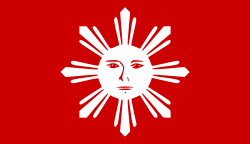1897 Philippine Supreme Council elections
On November 1, 1897, the Republic of Biak-na-Bato was established in the cave of Biak-na-Bato, San Miguel de Mayumo, Bulacan. A special election was called for the new Supreme Council to oversee the newly established government on November 2, 1897 in the Philippines.
 |
|---|
| This article is part of a series on the politics and government of the Philippines |
|
|
|
Constitutional commissions |
|
Related topics |
|
|
Results
The election results were as follows:[1][2]
| Position | Name |
|---|---|
| President | Emilio Aguinaldo |
| Vice-President | Mariano Trías |
| Secretary of Foreign Affairs | Antonio Montenegro |
| Secretary of War | Emiliano Riego de Dios |
| Secretary of the Interior | Isabelo Artacho |
| Secretary of the Treasury | Baldomero Aguinaldo |
Pact of Biak-na-Bato

On December 14, 1897, the Pact of Biak-na-Bato was signed. Under the pact, Aguinaldo agreed to end hostilities and to exile himself and the revolutionary leadership, in exchange for amnesty and cash 'indemnities' in the amount of 800,000 pesos.[3] Aguinaldo took the money offered and, along with 34 other leaders of the rebellion, exiled himself in Hong Kong. The following were the officers of the Supreme Council that oversaw the pact. Emilio Aguinaldo was President and Mariano Trias, the Vice President. Other officials included Antonio Montenegro for Foreign Affairs, Isabelo Artacho for the Interior, Baldomero Aguinaldo for the Treasury, and Emiliano Riego de Dios for War.
See also
References
-
- Agoncillo, Teodoro C. (1990) [1960], History of the Filipino People (8th ed.), Quezon City: Garotech Publishing, p. 182, ISBN 971-8711-06-6
-
- Zaide, Sonia M. (1994), The Philippines: A Unique Nation, All-Nations Publishing Co., pp. 251–252, ISBN 971-642-071-4
-
- Aguinaldo, Don Emilio y Famy, "Chapter II. The Treaty of Biak-na-bató", True Version of the Philippine Revolution, Authorama: Public Domain Books, retrieved 2010-07-24